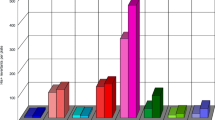Summary
By assaying transposition of Tn5 from λb221 cI857 rex::Tn5 (Berg 1977) in PolA-proficient and deficient cells, both the polymerase activity and 5′ to 3′ exonuclease acivity of DNA polymerase I have been shown to be required for transposition. This requirement could not be observed in three other systems in which the transposon donor replicon had existed in the PolA-proficient and deficient cells before the transposition event to be assayed occurred. By analogy to Tn3, this may indicate that the repressor encoded by Tn5 has already been expressed and hence become rate-limiting in the overall transposition process, even in PolA-deficient cells still possessing a residual activity. One polA mutant was found among more than 50 transposition-deficient (tnp) mutants isolated by the use of λb221 cI857 rex::Tn5.
Similar content being viewed by others
References
Arthur A, Sherratt D (1979) Dissection of the transposition process: A transposon-encoded site-specific recombination system. Mol Gen Genet 175:267–274
Beck CF, Moyed H, Ingraham JL (1980) The tetracycline-resistance transposon Tn10 inhibits translocation of Tn10. Mol Gen Genet 179:453–455
Bennett PM, Grinsted J, Richmond NH (1977) Transposition of TnA does not generate deletions. Mol Gen Genet 154:205–211
Berg DE (1977) Insertion and excision of the transposable kanamycin resistance determinant Tn5. In: Bukhari AI, Shapiro JA, Adhya SL (eds) DNA insertion elements, plasmids and episomes. Cold Spring Harbor Laboratory, New York, pp 205–218
Berg DE, Davies J, Allet B, Rochaix J-D (1975) Transposition of R factor genes to bacteriophage λ. Proc Natl Acad Sci USA 72:3628–3632
Biek D, Roth JR (1980) Regulation of Tn5 transposition in Salmonella typhimurium. Proc Natl Acad Sci USA 77:6047–6051
Calos MP, Johnsrud L, Miller JH (1978) DNA sequences at the integration sites of the insertion element IS1. Cell 13:411–418
Calos MP, Miller JH (1980) Transposable elements. Cell 20:579–595
Chou J, Lemaux PG, Casadaban MJ, Cohen SN (1979) Transposition protein of Tn3: identification and characterization of an essential repressor-controlled gene product. Nature (London) New Biol 282:801–806
Cohen SN, Casadaban MJ, Chou J, Tu CPD (1978) Studies of the specificity and control of transposition of the Tn3 elements. Cold Spring Harbor Symp Quant Biol 43:1247–1256
Cohen SN, Chang ACY, Hsu L (1972) Nonchromosomal antibiotic resistance in bacteria: genetic transformation of Escherichia coli by R factor DNA. Proc Natl Acad Sci USA 69:2110–2114
Ghosal D, Sommer H, Saedler H (1979) Nucleotide sequence of the transposable element IS2. Nucleic Acid Res 6:1111–1122
Gill G, Heffron F, Dougan G, Falkow S (1978) Analysis of sequence transposed by complementation of two classes of transposition-deficient mutants of Tn3. J Bacteriol 136:742–756
Gill RE, Heffron F, Falkow S (1979) Identification of the protein coded by the transposable element Tn3 which is required for its transposition. Nature (London) New Biol 282:797–801
Grindley NDF (1978) IS1 insertion generates duplication of a nine base sequence at its target site. Cell 13:419–426
Grindley NDF, Sherratt DJ (1978) Sequence analysis at IS1 sites: models for transposition. Cold Spring Harbor Symp Quant Biol 43:1257–1262
Habermann P, Klaer R, Kühn S, Starlinger P (1979) IS4 is formed between eleven or twelve base pair duplication. Mol Gen Genet 175:363–373
Jacob F, Wollman EL (1956) Sur les processus de conjugaison de et de recombinaison chez Escherichia coli. I. L'induction par conjugaison ou induction zygotique. Ann Inst Pasteur 91:486–510
Johnsrud L, Calos MP, Miller JH (1978) The transposon Tn9 generates a 9 bp repeated sequence during integration. Cell 13:1209–1219
Klaer R, Pfeiffer D, Starlinger P (1980) IS4 is still found in its chromosomal site after transposition to galT. Mol Gen Genet 178:281–284
Kleckner N (1977) Transposable elements in procaryotes. Cell 11:11–23
Kühn S, Frits HJ, Starlinger P (1979) Close vicinity of IS1 integration sites in the leader sequence of the gal operon of E. coli. Mol Gen Genet 167:235–241
Ljungquist E, Bukhari AI (1977) State of prophage Mu DNA upon induction. Proc Natl Acad Sci USA 74:3143–3147
Meyer R, Boch G, Shapiro J (1979) Transposition of DNA inserted into deletions of the Tn5 kanamycin resistance element. Mol Gen Genet 171:7–13
Miller JH (1972) Experiments in Molecular Genetics. Cold Spring Harbor Laboratory
Novick RP, Clowes RC, Cohen SN, Curtiss R, Datta N, Falkow S (1976) Uniform nomenclature for bacterial plasmids: a proposal. Bacteriol Rev 40:168–189
Oka A, Nomura N, Sugimoto K, Sugisaki H, Takanami M (1978) Nucleotide sequence at the insertion site of a kanamycin transposon. Nature (London) New Biol 276:845–847
Pardee AB, Jacob F, Monod J (1959) The genetic control and cytoplasmic expression of “inducibility” in the synthesis of β-galactosidase by E. coli. J Mol Biol 1:165–178
Rothstein SJ, Jorgensen RA, Postel K, Reznikoff WS (1980) The inverted repeats of Tn5 are functionally different. Cell 19:795–805
Sasakwa C, Yoshikawa M (1978) Requirements for suppression of a dnaG mutation by an I-type plasmid. J Bacteriol 133:485–491
Sasakawa C, Yoshikawa M (1980) Transposon (Tn5)-mediated suppressive integration of ColE1 derivatives into the chromosome of Escherichia coli K12 (dnaA). Biochem Biophys Res Commun 96:1357–1363
Schaller H (1978) The intergenic region and the origins for filamentous phage DNA replication. Cold Spring Harbor Symp Quant Biol 43:401–408
Shapiro JA (1979) A molecular model for the transposition and replication of bacteriophage Mu and other transposable elements. Proc Natl Acad Sci USA 76:1933–1937
Starlinger P (1980) IS elements and transposons. Plasmid 3:241–259
Stocker BAD, Smith SM, Ozeki H (1963) High infectivity of Salmonella typhimurium newly infected by the coll factor. J Gen Microbiol 30:201–221
Zissler J, Signer E, Schaefer F (1971) In: Hershey AD (ed) The Bacteriophage Lambda. Cold Spring Harbor Laboratory, New York, p 469
Author information
Authors and Affiliations
Additional information
Communicated by E. Bautz
Rights and permissions
About this article
Cite this article
Sasakawa, C., Uno, Y. & Yoshikawa, M. The requirement for both DNA polymerase and 5′ to 3′ exonuclease activities of DNA polymerase I during Tn5 transposition. Molec. Gen. Genet. 182, 19–24 (1981). https://doi.org/10.1007/BF00422761
Received:
Issue Date:
DOI: https://doi.org/10.1007/BF00422761




